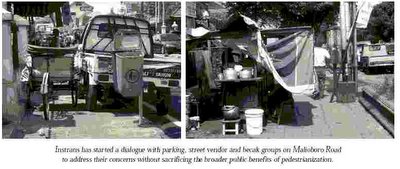I was struck by the article "Pedestrianization in Yogyakarta: Transforming the Malioboro One Step at a Time". It offers a fascinating insight into the complex range of actors involved as local academics, the local authorities and NGOs try to launch a pedestrianisation effort in Yogyakarta's main street - Malioboro.
We had been warned by Electrowatt’s consultants that the real problem lay in the opposition from groups representing parking, becak, and street vendor interests. Instran began a dialog with these various interest groups, to see whether or not a plan could be developed that incorporated their concerns without sacrificing the public interest. This analysis showed that at least 13 groups were profiting from the appropriation of public space along Malioboro Road. These groups include all strata of society. Six were vendors associations that controlled specific localities. Several were becak unions. Several other were organized societies of street children who make a few pennies helping the vendors with minor tasks. One or two were legal chambers of commerce. The rest are basically protection rackets and criminal gangs, mostly controlling the parking, with connections all the way up to senior government figures who earn a few dollars by pretending not to notice the expropriation of public space by private interests.Wow! That is a little sobering. In such a context efforts to move forward with a pedestrianisation plan are obviously very complex, as the article discusses in some depth. Such insights are an important antitode to technocractic thinking for anyone seeking to transform public spaces in cities.
Among those groups, the parking attendants and the groups that control them are clearly the most powerful and profitable. In addition, the structure of the parking industry turned out to be much more complex than anyone had imagined.

It will be interesting to watch as the story unfolds further.

No comments:
Post a Comment